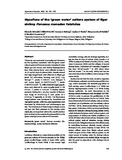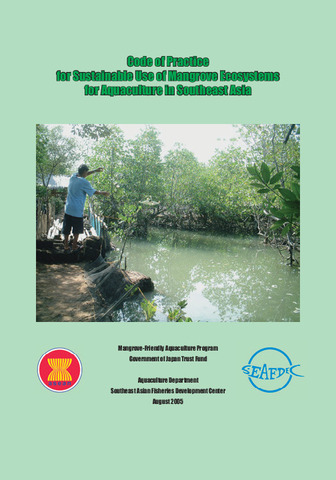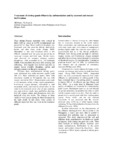Mycoflora of the 'green water' culture system of tiger shrimp Penaeus monodon Fabricius
- Global styles
- MLA
- Vancouver
- Elsevier - Harvard
- APA
- Help

View/
Date
2005Author
Page views
3,148ASFA keyword
AGROVOC keyword
Taxonomic term
Metadata
Perlihat publikasi penuh
Share
Abstract
This study was conducted to quantify and characterize the mycoflora associated with the ‘green water’ culture system of Penaeus monodon. Samples of water, tilapia gut and mucus, and shrimp hepatopancreas from three shrimp farms were collected during 15, 30, 45 and 60 days of culture (DOC). Results showed that high fungal loads were observed in tilapia gut (total: 117–1352 colony forming unit (CFU) 5 cm hind gut−1; yeasts: 0–136 CFU 5 cm hind gut−1) and mucus (total: 12–311 CFU (5 cm2)−1; yeasts: 0–88 CFU (5 cm2)−1), while minimal fungal populations were observed in water samples (total: 0–110CFU mL−1; yeasts: 0–5 CFU ml−1). Shrimp hepatopancreas harboured a very low number of filamentous fungi (0–27 CFU 0.1 g−1) and yeasts (0–7CFU 0.1 g−1) especially at 60 DOC. The filamentous fungal isolates were dominated by Penicillium and Aspergillus species, while the yeast populations were dominated by Rhodotorula and Saccharomyces species. The dominance of these fungi on tilapia mucus and gut and their presence in the rearing water might play an important role in the overall mechanisms involved in the control of luminous Vibrio in the ‘green water’ grow-out culture of P. monodon.
Suggested Citation
Leaño, E. M., Lio-Po, G. D., Nadong, L. A., Tirado, A. C., Sadaba, R. B., & Guanzon, N. G. (2005). Mycoflora of the 'green water' culture system of tiger shrimp Penaeus monodon Fabricius. Aquaculture Research , 36(16), 1581-1587. https://doi.org/10.1111/j.1365-2109.2005.01381.x
Type
ArticleKoleksi
- Journal Articles [1258]
Related items
Showing items related by title, author, creator and subject.
-
The growth, survival and production of shrimp (Penaeus monodon) cultured with green mussel (Perna viridis) in semi-intensive ponds
Corre, Kaylin G.; Corre, Valeriano L.; Gallardo, Wenresti (University of Philippines in the Visayas, 1997)The culture of tiger shrimps (Penaeus monodon) with and without green mussels (Perna viridis) was compared in terms of animal growth, survival, production, and pond water quality. Tiger shrimps (2.6 g) were stocked at ... -
Code of practice for sustainable use of mangrove ecosystems for aquaculture in Southeast Asia
This 47-page guidebook presents the 22 concepts, principles or policy statements that prescribe the preferred ways of doing and acting to ensure the sustainable use of mangroves for fish farming. It is annotated with ... -
Treatment of shrimp pond effluents by sedimentation and by seaweed and mussel biofiltration
Fortes, Norma R.; Corre, Valeriano L., Jr. (Bureau of Agricultural Research, Department of Agriculture, 2007)Tiger shrimp Penaeus monodon were stocked in three 1,000 m2 ponds at 12,000 juveniles/pond and grown for 141 days. Water quality in the ponds was monitored over the grow-out period, particularly before and after ...






